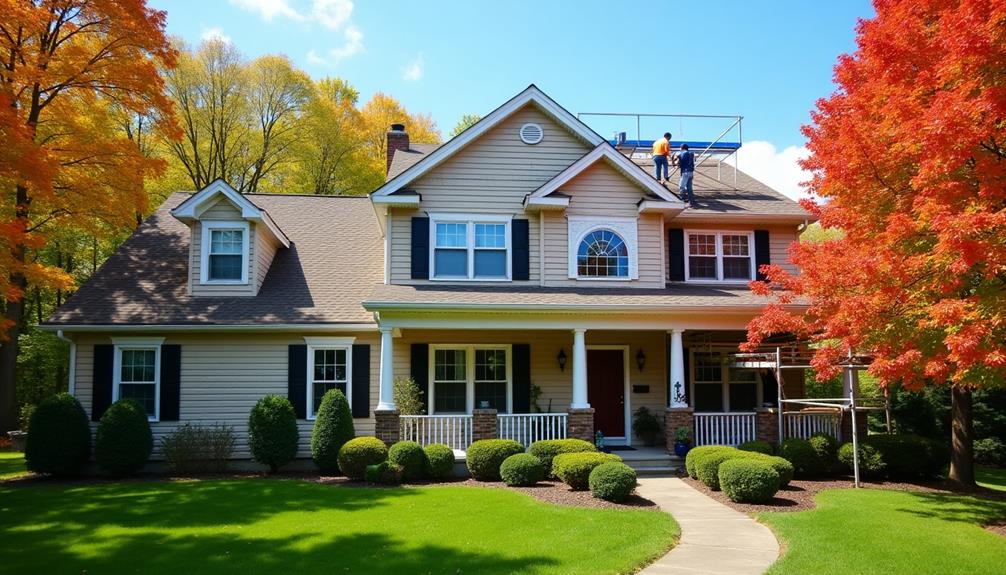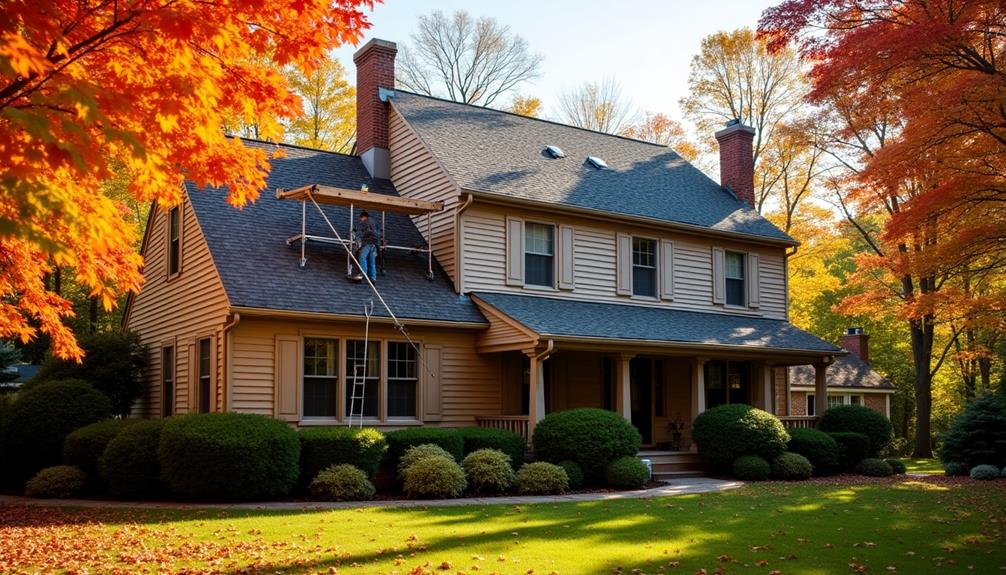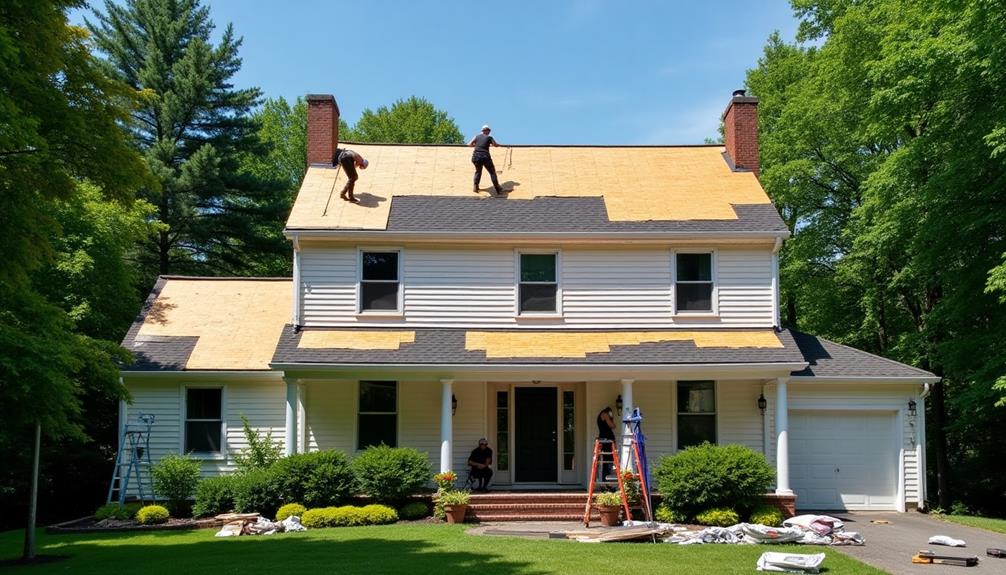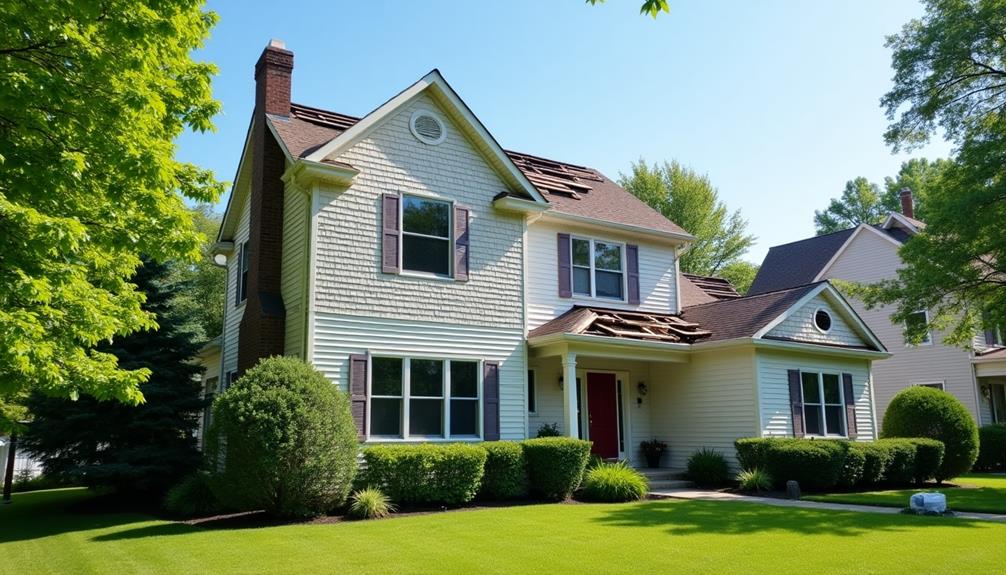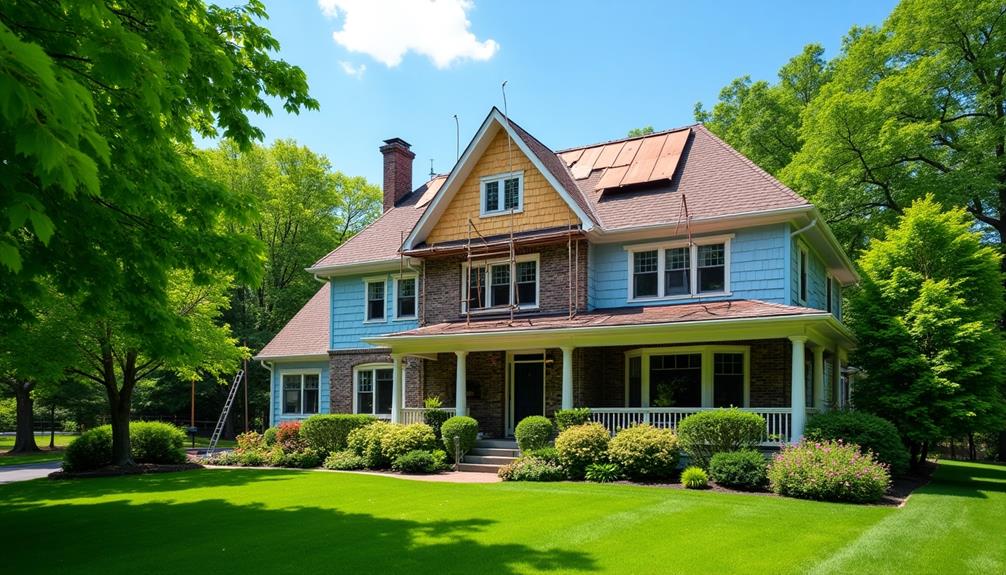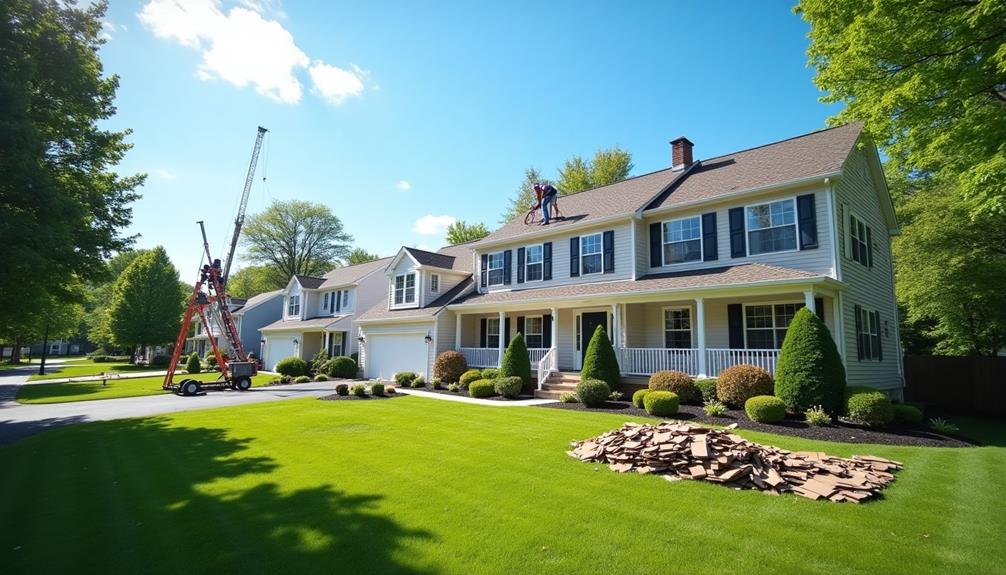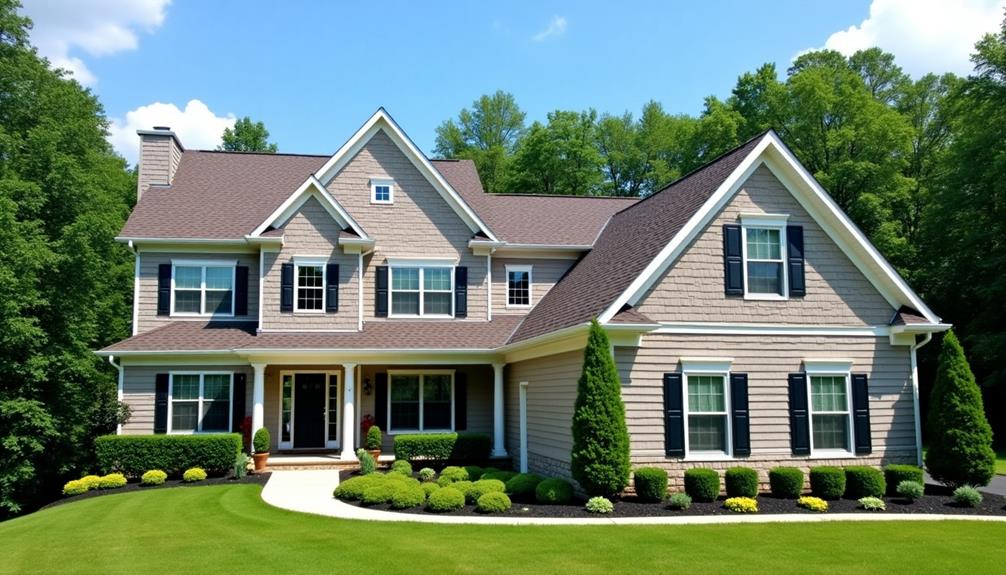If you're considering roof replacement in Pine Hill, NJ, watch for signs like leaks, high energy bills, or damaged shingles. Roofs typically last around 20 years, but various materials can alter longevity. Be mindful of costs related to size, material, and labor. Selecting a qualified contractor is crucial; ensure they're licensed and have good reviews. Don't forget about local permits and regulations before starting the work. A new roof boosts your home's energy efficiency and curb appeal, while also preventing structural damage. There's more to explore on how to streamline your replacement process and maximize your investment.
Signs You Need a Replacement
When it comes to your roof, several key signs indicate that a replacement might be necessary. One of the most obvious signs is the presence of roof leaks. If you notice water stains on your ceiling or walls, it's crucial to investigate further. Persistent leaks can compromise your home's structural integrity and lead to mold growth, which poses health risks.
Another critical factor is energy efficiency. An aging or damaged roof may not insulate your home properly, leading to increased energy bills. If you find your heating and cooling systems working overtime to maintain a comfortable temperature, it's time to assess your roof's condition. Look for missing or damaged shingles, as these can significantly impact energy efficiency.
Additionally, granule loss on your shingles can indicate that your roof is nearing the end of its lifespan. If you observe shingle granules in your gutters or downspouts, this is a clear warning sign.
Lastly, if your roof is more than 20 years old, it's wise to consult a roofing professional to evaluate its condition. Taking these signs seriously can save you time and money in the long run.
Understanding Roof Lifespan
Understanding the lifespan of your roof is crucial for effective maintenance and timely replacements.
You'll want to consider the common roofing materials available, as each has its own longevity and durability.
Additionally, various factors can influence how long your roof lasts, so recognizing the signs that indicate a replacement is necessary is essential for protecting your home.
Common Roofing Materials
Selecting the right roofing material is crucial for ensuring the longevity and performance of your roof. Various materials offer distinct advantages, and understanding these can guide your decision-making process.
Asphalt shingles are a popular choice due to their affordability and ease of installation techniques, making them a go-to for many homeowners.
Metal roofing, on the other hand, is known for its exceptional durability and weather resistance, often lasting twice as long as asphalt.
If aesthetics is a priority, tile roofing and slate roofs provide beautiful options that enhance your home's curb appeal, though they typically come with higher costs.
Durability comparisons between these materials reveal that while asphalt may last 20 years, metal roofs can last upwards of 50 years, and slate can exceed 100 years.
Moreover, eco-friendly options like reflective metal can reduce energy costs, aligning with sustainable building practices.
Conducting a cost analysis will help you weigh initial expenses against long-term benefits, ensuring you choose a material that fits your budget and lifestyle.
Factors Affecting Longevity
The lifespan of your roof hinges on several critical factors that can significantly impact its durability and performance. One of the primary considerations is the quality of materials used in the roofing system. High-quality materials, such as architectural shingles or metal roofing, generally offer enhanced longevity compared to lower-grade options. Investing in premium materials can save you from costly replacements in the long run.
Another crucial factor is weather conditions in Pine Hill, NJ. Your roof endures various environmental stresses, including heavy rain, snow, and fluctuating temperatures. These elements can accelerate wear and tear. For instance, consistent exposure to harsh UV rays can deteriorate roofing materials, while excessive moisture can lead to mold and mildew growth.
Additionally, proper installation plays a vital role in how well your roof withstands these conditions. A poorly installed roof may develop leaks or structural weaknesses sooner than expected.
Regular maintenance also can't be overlooked; routine inspections and timely repairs can extend your roof's lifespan significantly. By considering these factors—material quality, weather conditions, and installation integrity—you can make informed decisions that ensure your roof remains reliable for years to come.
Signs of Replacement Needed
Recognizing when it's time to replace your roof is vital for maintaining the integrity of your home. Several signs indicate a roof replacement is necessary, and understanding these can save you from costly repairs down the line.
Pay attention to the following indicators:
| Signs of Replacement | Description | Action Required |
|---|---|---|
| Visible Damage | Missing shingles or cracks | Schedule a leak detection check |
| Water Stains on Ceiling | Indicates potential leaks | Inspect roof and consider replacement |
| Age of Roof | Over 20 years | Assess overall condition |
Weather impact plays a significant role in roof deterioration. Severe storms, heavy snow, or high winds can exacerbate existing weaknesses. Regular inspections will help in early leak detection, allowing you to address issues before they escalate.
If you notice any of these signs, consult a roofing professional to evaluate your roof's condition. Proactive measures can extend its lifespan and protect your home from extensive damage. Don't wait until more severe problems arise; addressing these issues now ensures your home remains safe and secure.
Factors Affecting Replacement Costs
When considering roof replacement costs, several key factors come into play.
Your choice of roofing material, the dimensions of your roof, and the labor and installation costs can significantly impact your overall expenses.
Understanding these elements will help you make informed decisions and budget effectively for your project.
Roofing Material Choice
Choosing the right roofing material can significantly impact your overall replacement costs. Various factors come into play, including energy efficiency and material durability.
When selecting a material, consider how it affects your home's energy consumption. For instance, reflective materials can lower cooling costs during hot months, while insulated options may reduce heating expenses in winter.
Material durability is another crucial element. Investing in high-quality materials like metal or slate may incur higher upfront costs but often leads to lower maintenance and replacement expenses over time. These durable options can withstand harsh weather conditions, extending your roof's lifespan and providing long-term savings.
Additionally, the local climate in Pine Hill, NJ, plays a role in your material choice. Certain materials may perform better in specific weather conditions, influencing your overall costs.
It's essential to balance initial investment with potential savings from energy efficiency and longevity. By carefully evaluating these factors, you can make an informed decision that aligns with your budget and long-term goals for your home.
Roof Size Dimensions
Determining your roof size dimensions is a critical factor that directly impacts replacement costs. Accurate roof measurements ensure you understand the total area needing replacement, which influences material quantity and overall labor expenses.
To effectively assess your roof size, you'll want to employ reliable roof measurement techniques. Start by measuring the length and width of each section of your roof. For simple rectangular or square roofs, multiply these dimensions to calculate roof area.
For more complex shapes, consider breaking the roof into smaller sections and summing their areas. If your roof has slopes, use the pitch to adjust your calculations. The pitch can significantly affect the total area, so measuring it correctly is essential.
You can also use tools like a digital measuring device or an app designed for roof measurements to enhance accuracy.
Labor and Installation Costs
After assessing your roof size dimensions, the next significant factor to consider is labor and installation costs. These costs can vary widely based on several key elements.
Firstly, labor rates play a crucial role; skilled roofing contractors may charge higher rates due to their expertise and the quality of work they provide. It's essential to obtain multiple quotes to ensure you're getting a fair price.
Additionally, the installation techniques chosen for your roof replacement will impact overall costs. For instance, standard asphalt shingles are generally less expensive to install compared to intricate roofing materials like slate or metal. Complex roof designs requiring specialized installation techniques will also increase labor time and, consequently, costs.
Another factor to consider is the geographical location, as labor rates can differ from one region to another. In Pine Hill, NJ, you may encounter specific local regulations or codes that could affect the installation process, leading to additional expenses.
Ultimately, understanding these components will help you budget effectively for your roof replacement, ensuring you receive a quality installation that meets your needs without overspending.
Best Roofing Materials for Pine Hill
When it comes to roofing in Pine Hill, selecting the right materials is crucial for durability and performance. You need to consider the local climate, which influences the effectiveness of different roofing options.
Asphalt shingles are popular due to their cost effectiveness, energy efficiency, and various color selections, allowing for aesthetic appeal.
Metal roofing offers exceptional durability and longevity, making it a strong candidate. Its reflective properties enhance energy efficiency, and it can reduce noise when installed with proper insulation techniques.
For environmentally-conscious homeowners, consider options like recycled shingles or green roofs, which minimize environmental impact and promote sustainability.
When comparing durability, materials like slate and tile provide longevity but may come with higher installation costs. Ensure you're aware of warranty options available for each material—these can vary significantly.
Installation techniques also play a role; proper installation can enhance performance and lifespan.
Ultimately, weigh the benefits of each material against your budget and desired aesthetic appeal. By doing so, you'll make an informed decision that balances durability, cost, and overall satisfaction with your new roof in Pine Hill.
Preparing for Roof Replacement
Preparing for a roof replacement involves several key steps to ensure a smooth and efficient process.
First, conduct thorough site preparation. Clear the area around your home, removing any debris, furniture, or vehicles that might obstruct the work. This helps the roofing team access your roof easily and reduces the risk of damage to your property.
Next, consider the weather. Before scheduling your roof replacement, check the forecast for Pine Hill, NJ. Ideally, choose a time when dry and mild weather is expected. Rain or high winds can delay the project and compromise the safety of the workers. If adverse weather conditions arise, be flexible and prepared to reschedule.
Additionally, inform your neighbors about the upcoming work. This courtesy can prevent misunderstandings and prepare them for potential noise and activity.
Ensure you've communicated any specific concerns, such as property boundaries or access pathways.
Choosing the Right Contractor
Selecting the right contractor is crucial for a successful roof replacement in Pine Hill, NJ. You need to ensure the contractor has the necessary qualifications and experience to handle your project effectively. Start by checking their licensing and insurance; these are essential indicators of their legitimacy and professionalism.
Don't hesitate to ask for references and examples of completed work. This will give you insight into their craftsmanship and reliability. Contractor reviews are invaluable in this process. Websites like Yelp or Google Reviews can provide real customer feedback, helping you gauge satisfaction levels and potential red flags.
Moreover, it's wise to interview multiple contractors. During these discussions, inquire about their specific experience with roof replacements similar to yours. A qualified contractor won't only be knowledgeable but also able to provide a detailed estimate outlining materials and timelines.
Lastly, remember that communication is key. A contractor who listens to your concerns and clearly explains the process can make your experience much smoother.
Permits and Regulations in NJ
Navigating the permits and regulations for roof replacement in New Jersey is essential to ensure your project complies with local laws.
You'll need to familiarize yourself with various building codes and zoning regulations that apply to your area. Start by checking with your local municipality to understand the specific permit process. Often, obtaining a permit is a prerequisite before any work begins.
Homeowner responsibilities also include ensuring that your project meets inspection requirements at various stages. After submitting your plans, you may need to schedule inspections to verify compliance with local ordinances and safety standards.
It's crucial to adhere to compliance guidelines to avoid potential fines or project delays. Additionally, consider environmental considerations such as proper disposal of old roofing materials, which may be regulated.
Failing to follow these regulations can lead to complications down the line. Therefore, make sure to keep detailed records of all permits, inspections, and communications with local authorities.
Benefits of Roof Replacement
Roof replacement offers numerous advantages that can significantly enhance your home's value and efficiency. One of the primary benefits is improved energy efficiency. Modern roofing materials often feature better insulation and reflective properties, helping to reduce heating and cooling costs. By replacing your outdated roof, you could see a decrease in energy bills, making your home more environmentally friendly and cost-effective.
Additionally, a new roof can dramatically boost your home's aesthetic appeal. Whether you choose a traditional style or a modern design, a fresh roof can transform your home's exterior, giving it a new lease on life. This enhancement not only creates a more inviting atmosphere but can also increase your property's market value.
Moreover, a roof replacement can provide you with advanced materials that offer increased durability and resistance to weather-related wear and tear. This longevity ensures your investment is safeguarded for years to come, reducing the need for frequent repairs.
Maintenance Tips After Replacement
After investing in a new roof, regular maintenance is essential to ensure its longevity and performance. Implementing a systematic roofing maintenance schedule will help you manage post installation care effectively. Here are some essential tips to keep your roof in prime condition:
| Task | Frequency |
|---|---|
| Inspect for debris | Monthly |
| Clean gutters | Biannually |
| Check for leaks | After heavy rains |
In addition to these tasks, look for signs of wear, such as curling shingles or rusted flashing. Address minor issues promptly to prevent more significant problems down the line.
You should also trim overhanging branches to minimize the risk of damage from falling limbs. If your area experiences heavy storms, consider a thorough inspection afterward.
Invest in professional assessments every few years, especially if you notice any irregularities. By adhering to this roofing maintenance schedule and engaging in diligent post installation care, you're not only protecting your investment but also ensuring your home remains secure and energy-efficient for years to come.

